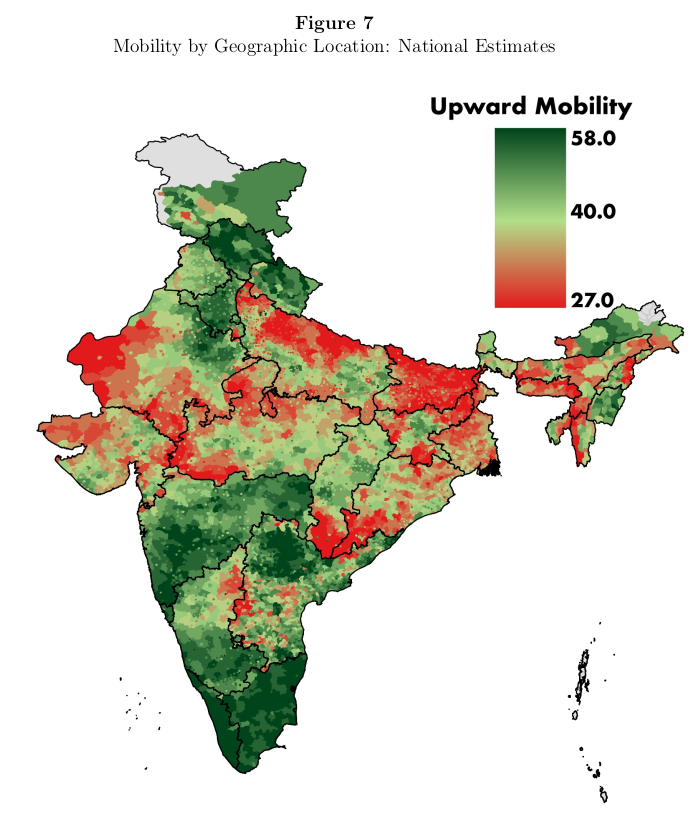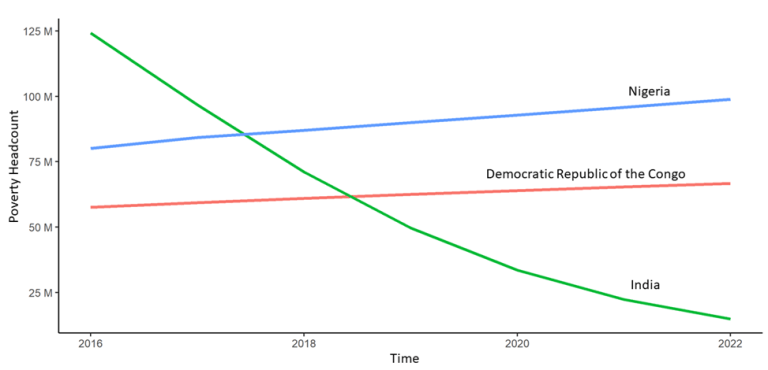
The above figure is from Intergenerational Mobility in India: Estimates from New Methods and Administrative Data. Since everyone is talking about the caste results, I wanted to highlight geography.
Tag: economics
East Bengal/Pakistan catches up to West Bengal/Pakistan
Today I was looking on the internet to get some more information on the Pakistan election. Honestly, I don’t have a strong opinion….
But by chance, I ended up stumbling on articles like this, When East overtakes West:
…a recent article, “East overtakes West,” in The Economist has thrown a spanner in the works. The east is the erstwhile East Pakistan and the west is today’s Pakistan. It shows that the GDP per capita of Bangladesh is $1,538 and that of Pakistan lags behind at $1,470. This is the result of a GDP growth rate of over six per cent per annum in the past 12 years. One-third of the GDP is contributed by industry and the value-added garments exports are larger than India and Pakistan put together.
The truth is that Bangladesh’s better statistics in some measures are due to demographics. Per capita values will change in opposite directions if nation underestimated its population (as Bangladesh did), and another nation overestimated its population (as Pakistan did). Using PPP corrections and such Pakistan is still a more prosperous land per person. But it’s getting close. The trendline is definitely pointing in one direction. A piece at Brookings asks “Why is Bangladesh booming?” The author notes:
Once one of the poorest regions of Pakistan, Bangladesh remained an economic basket case—wracked by poverty and famine—for many years after independence in 1971. In fact, by 2006, conditions seemed so hopeless that when Bangladesh registered faster growth than Pakistan, it was dismissed as a fluke.
But I’ve always thought that the infant mortality and life expectancy statistics in Bangladesh were things that were more important to be proud of (and on this score Bangladesh does indisputably better than Pakistan). And curiously, on this measure, Bangladesh does even better than India! But to a great extent, that’s not a fair comparison, as India is a coalition of regions, while Bangladesh would just be a very populous Indian state.
More comparable is West Bengal. Bangladesh and West Bengal look to be at parity in terms of life expectancy and per capita GDP. And metropolitan Dhaka and Kolkotta now have about the same population, at ~15,000,000.
We live in interesting times.
The decline in South Asian poverty
It has long been asserted that South Asia may make average strides economically, but it is still in absolute terms the locus of most of the world’s grinding poverty. This may not be true much longer. In particular, some estimates now suggest that India is no longer the world’s “leader” in extreme poverty in absolute terms. From Brookings, The start of a new poverty narrative:
According to our projections, Nigeria has already overtaken India as the country with the largest number of extreme poor in early 2018, and the Democratic Republic of the Congo could soon take over the number 2 spot (Figure 1 below). At the end of May 2018, our trajectories suggest that Nigeria had about 87 million people in extreme poverty, compared with India’s 73 million. What is more, extreme poverty in Nigeria is growing by six people every minute, while poverty in India continues to fall. In fact, by the end of 2018 in Africa as a whole, there will probably be about 3.2 million more people living in extreme poverty than there are today.
Bangladesh has been making progress as well, from the World Bank:
Bangladesh has made remarkable progress in reducing poverty, supported by sustained economic growth. Based on the international poverty line of $1.90 per person per day, it reduced poverty from 44.2 percent in 1991 to 13.8 percent in 2016/17. In parallel, life expectancy, literacy rates and per capita food production have increased significantly. Progress was underpinned by 6 percent plus growth over the decade and reaching to 7.3 percent in 2016/2017, according to official estimates. Rapid growth enabled Bangladesh to reach the lower middle-income country status in 2015. In 2018, Bangladesh fulfilled all three eligibility criteria for graduation from the UN’s Least Developed Countries (LDC) list for the first time and is on track for graduation in 2024.
Here’s GDP for South Asian countries in 2005 dollars:
I left Bangladesh in 1980. Not too long after I was born. I went back to visit in 1989 and 2004. In relation to 1980, per capita GDP was 1.15x. in 2004 it was 1.6x. In 2016 it was 2.9x. So over the past 14 years there’s been a 2x increase in GDP per capita in Bangladesh! The equivalent figure in the United States is 1.1x.
